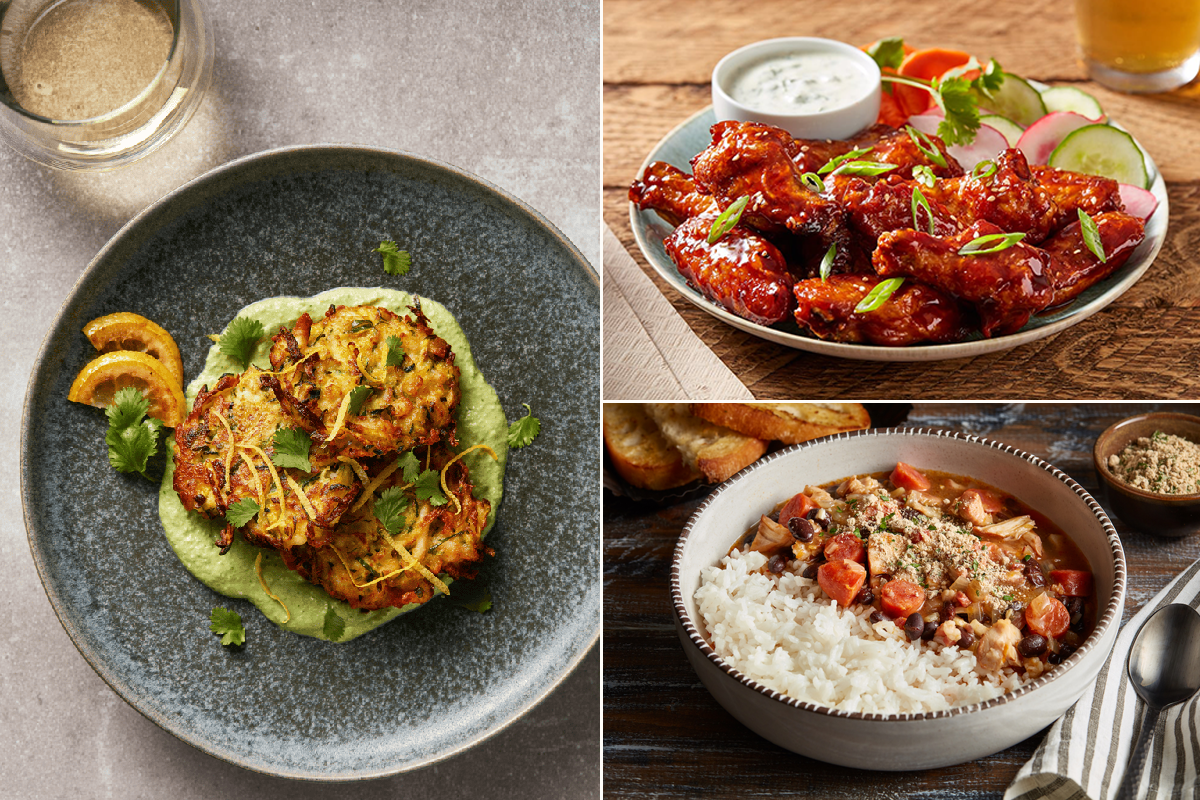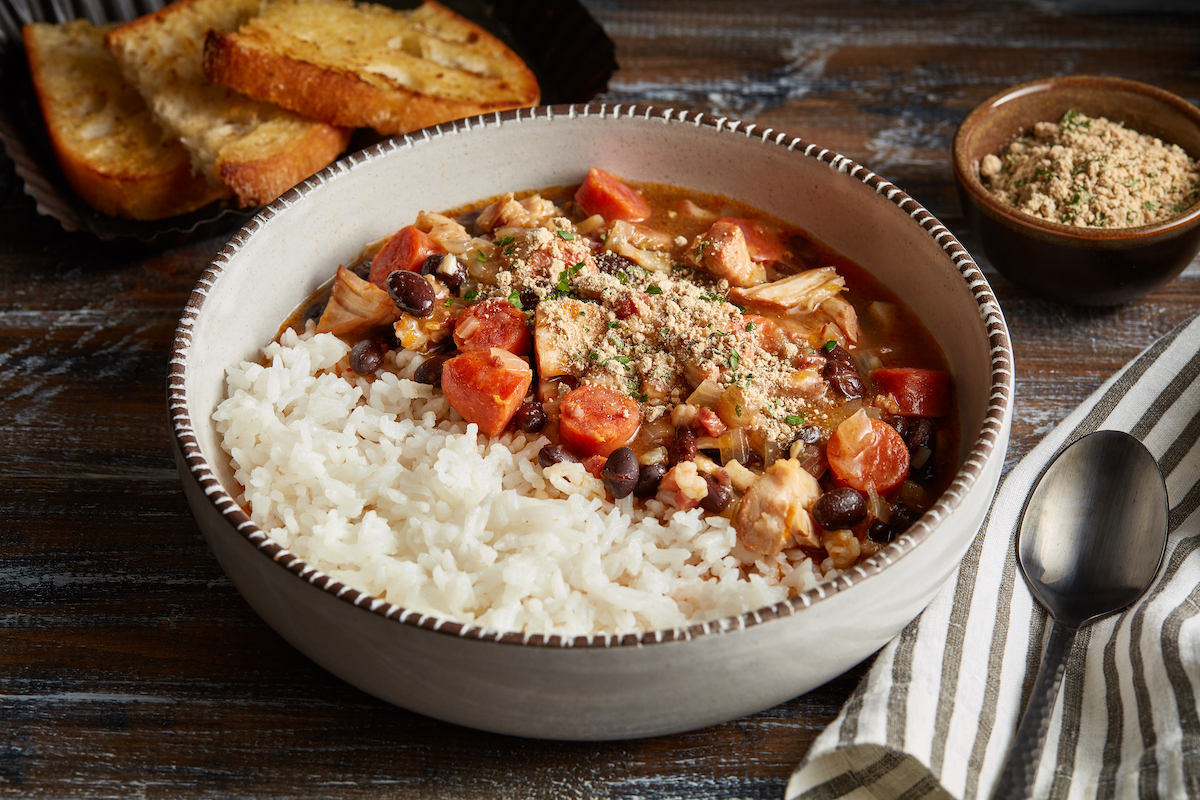


Katy Velazquez
Corporate Executive Chef
Qdoba
Kitchen Collaborative is a recipe-development initiative formed by Summit F&B and Flavor & The Menu. To fuel flavor innovation, a group of talented chefs partnered with sponsor brands and commodity boards to create recipes that showcase the passion and potential of our industry.
“I love when I fall in love with a flavor combination or a dish that someone has created—and then keep working on it until I’ve made it my own,” says Katy Velazquez of the inspiration she finds in the creations of her culinary peers. The Executive Corporate Chef of the fast-casual chain Qdoba Mexican Eats also admits to being somewhat “old school” when it comes to finding ideas in magazines and cookbooks. “I have a drawer full of recipe clips,” she says.
Velazquez’s natural zeal shines through in the words of her interview with Flavor & The Menu, whether she’s recounting an unforgettable taste experience (a chilled cucumber soup discovered while island-hopping in the Caribbean as a teen) or declaring her passion for wings (“I went to culinary school in Baltimore, so I love Old Bay, and there’s little better than a perfectly crispy Old Bay wing”). That gusto is also evident in the recipes she created for Kitchen Collaborative: Zucchini and Paneer Fritters with Cilantro Labneh; Confit Chicken Wings in Spicy Hoisin with Seaweed Ranch; and Feijoada.
Zucchini and Paneer Fritters with Cilantro Labneh
“I was initially thinking of presenting these fritters as a component of the ‘girl dinner’ trend,” says Velazquez of the in-vogue practice of cobbling together meals from various pantry snacks and items in the fridge. “I had made a big batch for my daughter—always trying to get more veggies into her diet—and incorporated leftovers into a few of my own meals later in the week. But after reworking the recipe and incorporating paneer—the California Dairy hero ingredient—the fritters felt like a star all on their own. They need more love than merely being served alongside a slice of tomato and piece of lunch meat.” Now, she typically serves these Zucchini and Paneer Fritters with Cilantro Labneh as an appetizer or side dish. “But they have crept their way into various dayparts, including breakfast and lunch/dinner as a great vegetarian entrée.”
Velazquez had been making the recipe for years without the paneer, but she finds the Indian cheese brings added value. “The grated paneer helps to give the fitters body and a delicious, salty flavor,” she explains. “With the paneer, the fritters feel more substantial, like a center-of-the-plate dish.” Real California Ricotta keeps the fritters light and moist, without bringing them into the “cakey territory” that comes with an added egg, Velazquez asserts.
The cilantro labneh has been in Velazquez’s toolbox for some time. She’d been working for Rick Bayless, testing recipes for his More Mexican Everyday cookbook, which features bases that can be adapted for different menu applications. “I had containers of this green, herby adobo coming out of my ears,” she recollects. “It was basically roasted garlic, olive oil and fresh herbs. I started folding it into yogurt as an easy sauce for proteins. When I discovered labneh a few years later, it took the game to another level. I love labneh and could eat it with a spoon.” One thing she likes the most is its versatility. “I will use it instead of buttermilk to marinate a whole chicken prior to roasting. It also makes a great, creamy salad dressing and veggie dip. I could go on for days with all the ways to use it,” she details.
Confit Chicken Wings in Spicy Hoisin with Seaweed Ranch
“I love chicken wings so much that it’s almost a problem,” Velazquez confesses. But don’t look for her to choose abstinence anytime soon. Presented with Lee Kum Kee® Hoisin Sauce for Kitchen Collaborative, “I knew immediately that it would be the perfect match for some confit chicken wings.” In fact, Velazquez goes all in on the Asian profile, adding the company’s Soy Sauce, Sriracha Chili Sauce and Chiu Chow Style Chili Oil to create this Confit Chicken Wings in Spicy Hoisin with Seaweed Ranch.
Velazquez starts by brining the chicken wings in a mix of soy sauce, brown sugar and water. “I love brining my proteins in soy sauce to keep them moist and seasoned all the way through from the skin into the meat. It also adds an umami richness to the brine,” she explains. “Since soy sauce has enough salt, it’s basically a ready-to-use brine.” A second best-in-class touch is using the double fry method—the first being at a low temp. “It’s the secret to the crispiest wings ever.”
The chef remained mindful about flavor balance. “Hoisin is deliciously sweet, and since I was tossing the wings in the hoisin sauce, I brought in the Sriracha to add a layer of heat,” she notes, characterizing the spicy heat as a 2.5 out of 5. Indeed, she says, “That’s the fun part of this recipe. You can scale the heat up or down by changing the amount of Sriracha. The chile crisp doesn’t impart a lot of heat, because it’s just a drizzle, but the color of that bright red oil over the seaweed ranch is just lovely.”
Let’s talk about that intriguing seaweed ranch dip. “I cannot take full credit,” admits Velazquez of putting her own spin on a recipe from Bon Appétit food editor Shilpa Uskokovic. “I made some changes to make it my own, but the flavor is so incredibly delicious, and it’s just as versatile as plain ranch, great as a dip, great with seafood or just a more exciting option for crudités.” Here, it’s the perfect balance to the sweet-and-spicy wings, delivering a refreshing coolness from the yogurt and a briny flavor from the seaweed.
Feijoada
Velazquez is quick to clarify that she is not Brazilian, and her take on Feijoada, the country’s national dish, is based on love rather than heritage. “I’ve been lucky to meet many incredible Brazilians and even luckier to have them cook for me. I fell in love with feijoada the first time I tasted it,” she explains.
This stew of beans and braised meat is the ultimate comfort food. Specifically, her recipe features black beans, onion, garlic, beef chorizo, bacon, orange zest, Custom Culinary® Beef Base, linguiça or longaniza sausage and baby back pork ribs. She uses a variation of farofa, a traditional Brazilian side dish of toasted cassava, as a topper to provide “a lovely texture and crunch. You will likely need to source cassava flour from a Brazilian market, but it’s totally worth it,” Velaquez advises, adding, “In a pinch, you could swap in plain breadcrumbs, but that will change the flavor profile.”
While feijoada is traditionally served with orange wedges on the side, “I never understood what to do with them,” she admits. “Instead, I add orange zest to the braising liquid to inject some brightness.” She also acknowledges that pork is traditionally the only featured meat. “But I love the flavor you get when combining beef and pork. Custom Culinary® Beef Base is an easy way to make the dish feel like it’s been made with a stock that took days to cook and reduce,” she says. “It adds depth and richness.”
While the linguiça or longaniza is a must-have ingredient (“it feels like the defining protein”), Velazquez notes that almost any other cut on hand could be applied with tasty results. “Beef or pork chuck would work, while a beef short rib could be luxurious. Really, the options are endless.” To this end, she points out that the chorizo is not a traditional element in Brazil. On one occasion, she turned to kielbasa and chorizo when linguiça or longaniza wasn’t available. “This emulated the texture of the sausages, and the chorizo lent some delicious spices and heat. Now, I can’t seem to quit the flavor of the chorizo, and I just keep using it.”
Project Management: Summit F&B
Photography: Carlos Garcia // Food Styling: Peg Blackley











